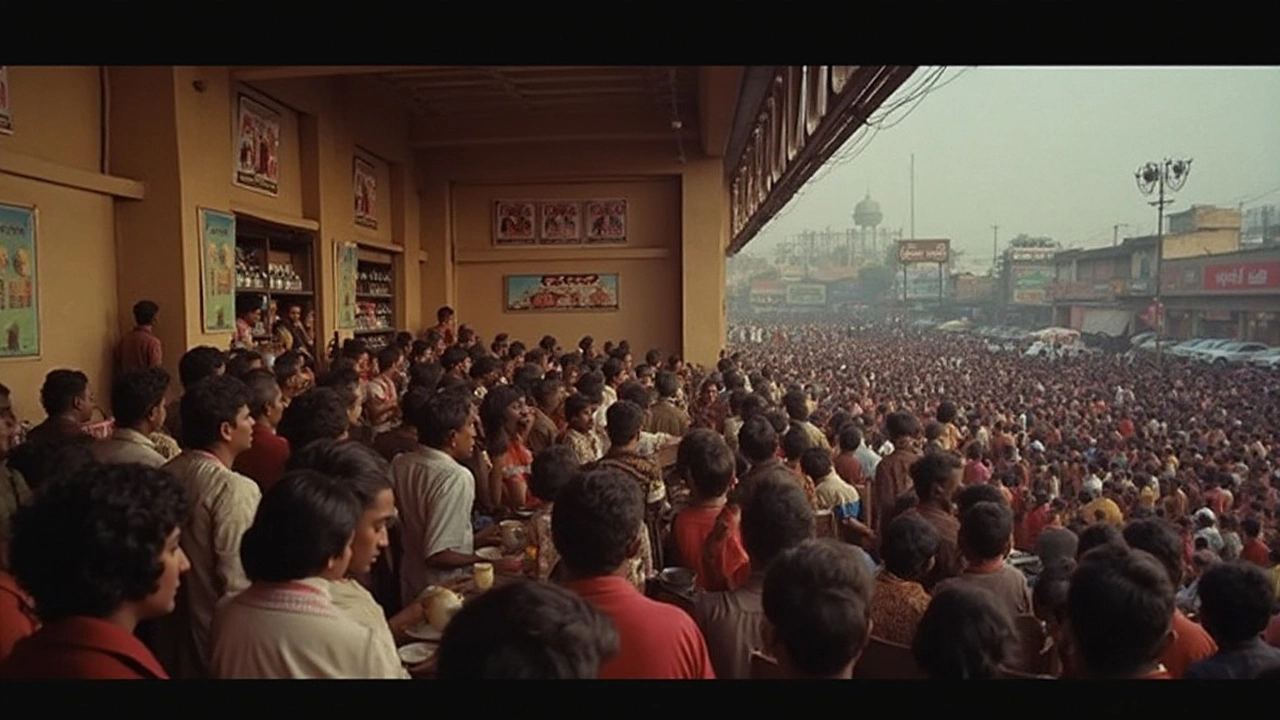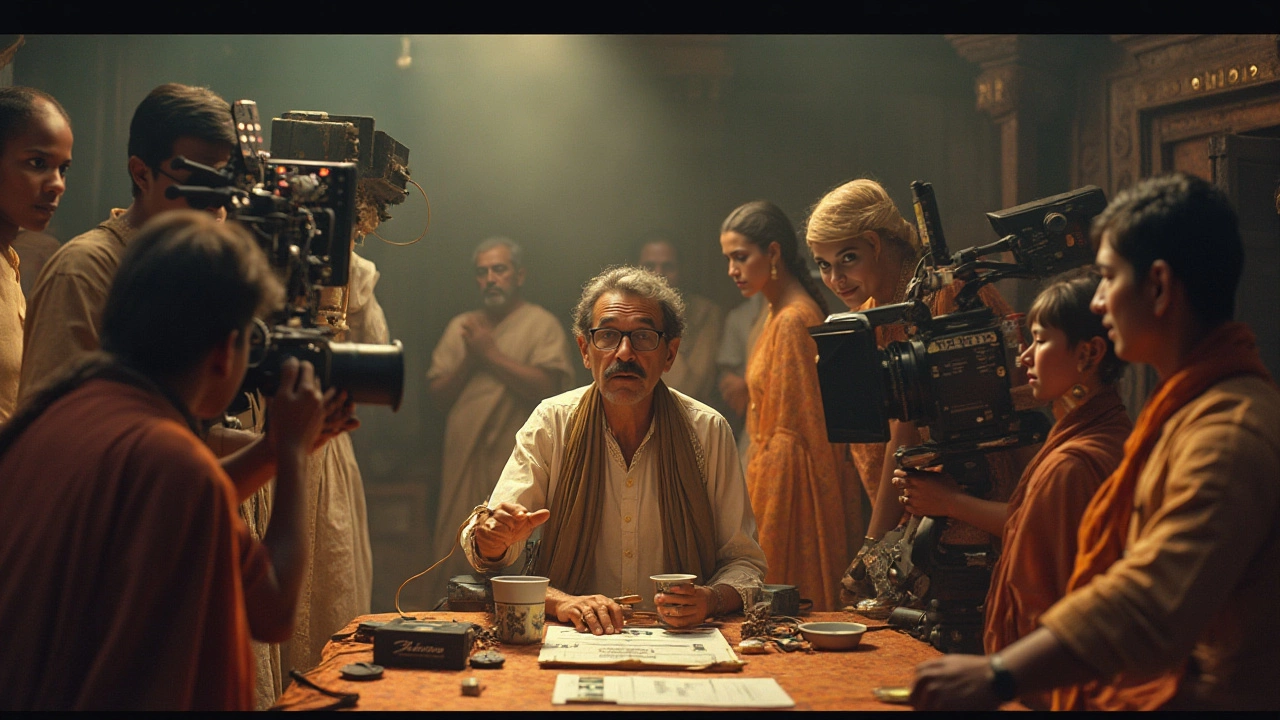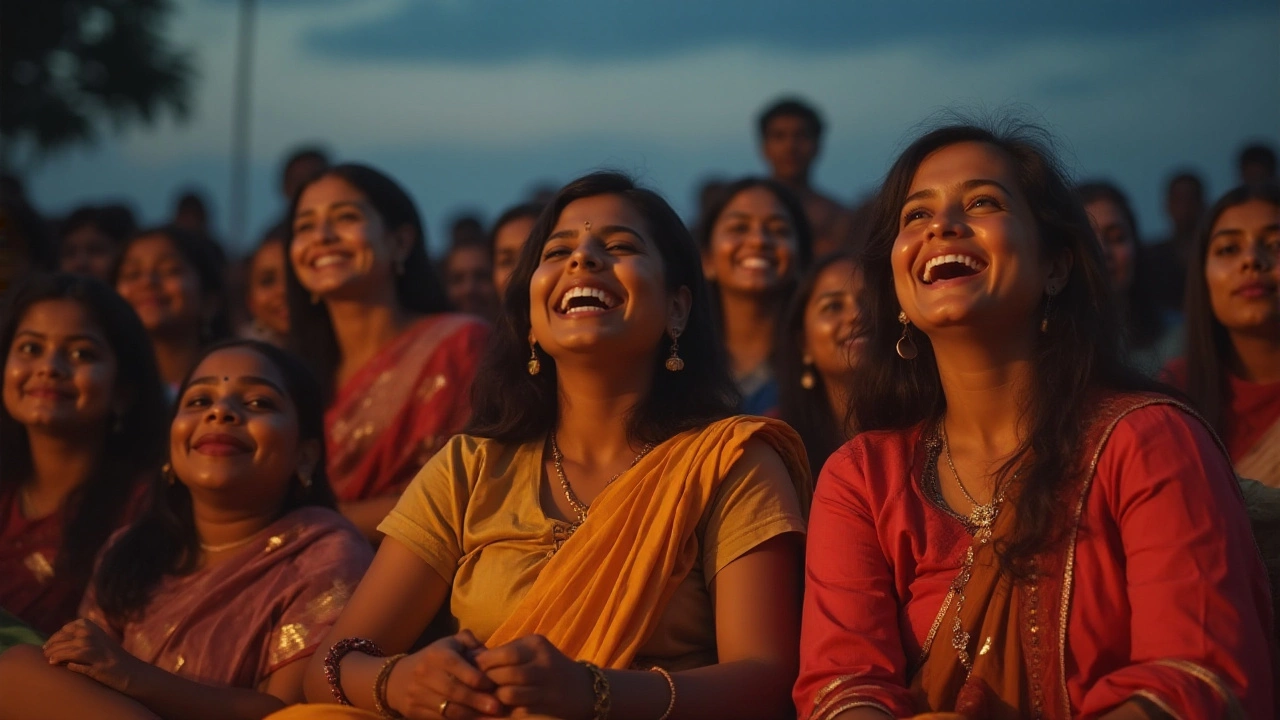Top Indian Movie Ticket Sales of All Time: A Closer Look
 Jan, 5 2025
Jan, 5 2025
Indian cinema, renowned for its vibrant storytelling and rich cultural tapestry, has gifted the world with numerous cinematic gems. Among countless noteworthy films, only a few have managed to capture the hearts of millions, leading to extraordinary ticket sales. The journey of these films from the screen to the hearts of audiences is as fascinating as the stories they tell.
With a robust film industry that churns out a staggering number of films each year, it's nothing short of a monumental achievement for any film to stand out not just in revenue but in the sheer volume of tickets sold. This rare feat speaks volumes about the film's universal appeal, cultural significance, and the ever-evolving preferences of cinema-goers. Come along as we explore the stories of these remarkable films and uncover the secrets behind their record-breaking success.
- The Golden Era of Indian Cinema
- Notable Movies and Their Influence
- Box Office Giants: Key Players
- Factors Behind High Ticket Sales
- Cultural Impact of Popular Films
- Modern Comparisons and Trends
The Golden Era of Indian Cinema
The period often referred to as the Golden Era of Indian cinema spans from the late 1940s to the 1960s. This was a transformative epoch, marked by the birth of independent India, which naturally reflected in its films. During these years, Indian cinema was synonymous with artistry and storytelling that delved deeply into socio-political themes, capturing the essence of a newly sovereign nation aiming to carve its identity. Filmmakers like Satyajit Ray, Bimal Roy, and Raj Kapoor rose to prominence, each contributing unique voices that resonated with audiences.
Distinct film styles emerged, enveloping viewers with narratives that were as diverse as the nation itself. On one hand, there was the parallel cinema movement, spearheaded by figures such as Mrinal Sen and Satyajit Ray, with films like “Pather Panchali” that offered a poignant, neo-realist depiction of rural India. On the other, mainstream cinema, with its melodious music and emotional storytelling, celebrated the vibrancy of everyday life. Films like Raj Kapoor's “Awara” became timeless classics, attracting a global audience, earning a place in the list of top Bollywood history films.
What set this era apart was not merely the box office triumph but the rich social commentary embedded in the narratives. Movies tackled issues such as poverty, caste discrimination, and the struggle for freedom, initiatives indicating how the art form evolved as a mirror to society's trials and triumphs. Often, the performances of stars like Dilip Kumar, Nargis, and Madhubala not only immortalized characters but also defined the standards of Indian cinema. Their movies created waves across borders, cementing India's position as a powerhouse of culture and cinema.
"Film-making in India is like unloading a lifeboat in the Titanic. It is an encompassing art form that changes with time." - Satyajit Ray
The vibrancy of this period is also bolstered by its unforgettable music. Songs from films became cultural touchstones, composed by maestros like S.D. Burman, Naushad, and R.D. Burman, whose compositions continue to pervade the auditory landscapes of Indian households today. These melodies were a key factor in the audience's love for cinema, intertwining storytelling with emotion in a way that left an indelible mark. The love for music and narrative blended seamlessly in a cinematic experience that was both compelling and communal, as families flocked to packed theaters.
This era also set the stage for high ticket sales, as films were a primary source of entertainment for a population hungry for new stories and vicarious adventures. Despite the economic challenges of post-independence India, the film industry flourished, with elaborate movie palaces springing up in urban centers. These theaters, often opulent, became gathering places for communities, where films were watched, discussed, and lived. The shared experience of cinema strengthened social bonds, fostering a collective appreciation for storytelling that celebrated life, love, and the human spirit in all its glory.
Notable Movies and Their Influence
Indian cinema, with its rich history and vast array of films, has captivated global audiences for more than a century. Among these myriad offerings stand a select few that have not only been commercial powerhouses but have also left a profound cultural impact. These movies are more than just box office hits; they're milestones in the cinematic landscape. Take, for instance, the epic saga of 'Sholay,' a film that, since its release in 1975, continues to be celebrated as one of the greatest examples of Indian cinema. With its dynamic characters, intense plot, and unforgettable dialogues, 'Sholay' set new benchmarks and became a cult classic. This film’s characters, especially the performances of Amitabh Bachchan and Dharmendra, became templates for future portrayals of heroes and anti-heroes alike in Bollywood.
Another remarkable masterpiece is 'Dilwale Dulhania Le Jayenge,' often referred to simply as 'DDLJ.' Released in 1995, this movie redefined love stories in Bollywood and is touted as the longest-running film in Indian cinema's history. Its success can be attributed to its perfect blend of romance, emotion, and music, which resonated not only with domestic audiences but also with the Indian diaspora worldwide. This movie placed Shah Rukh Khan and Kajol on the global movie map, establishing them as the quintessential romantic pair. 'DDLJ' played a vital role in heralding a new-age Bollywood, where traditional values were harmonized with modern storytelling.
Let's not overlook 'Baahubali' – a monumental film series that broke barriers and expectations within the Indian film industry. Directed by S.S. Rajamouli, these films were grand in both scale and vision. The impeccable production values, gripping storyline, and cutting-edge visual effects made 'Baahubali' a sensation not just in India but across the globe. Its unprecedented success demonstrated the potential of Indian cinema to match, if not exceed, Hollywood in epic storytelling ambitions. A testament to high ticket sales, it became one of the highest-grossing films in India, setting a new standard for future filmmakers.
To truly understand the influence of these films, consider the iconic songs that emerged from these movies, which continue to be played at celebrations, weddings, and even on regular days in households across India. Just like the films themselves, their soundtracks have transcended time. Additionally, their dialogues and scenes are often referenced in popular culture, inspiring new works and keeping older audiences nostalgically engaged. As the Indian film industry continues to grow and evolve, these notable films remain an essential part of its rich tapestry. They have laid down the foundation upon which the contemporary movie landscape is built and serve as beacons that guide both filmmakers and audiences towards a more vibrant future.

Box Office Giants: Key Players
The landscape of Indian cinema is adorned with several films that have achieved legendary status not only for their cinematic excellence but also for their phenomenal box office success. Among these, a few have managed to redefine the paradigm of popularity, selling an unprecedented number of tickets and cementing their place in cinema history. One such titan is the 1975 classic 'Sholay,' a film that shattered box office records with its gripping narrative and unforgettable characters. Despite its initial slow start, 'Sholay' went on to play continuously in some theaters for over five years, amassing an audience that mirrored the fervor of a nationwide festival.
Another standout is the epic 'Baahubali' series, which redefined how Bollywood and Indian films, in general, are perceived worldwide. Directed by S.S. Rajamouli, the two-part saga not only captivated audiences with its grandeur and intricate storytelling but also surpassed ticket sales expectations across global markets. The spectacle of 'Baahubali' transcended cultural boundaries, giving Indian cinema a new identity on the international stage. Interestingly, films such as 'Dilwale Dulhania Le Jayenge' and 'Mughal-e-Azam' remain etched in popular memory for their record-setting theater runs and vast appeal to audiences across different generations.
In the current era, 'Dangal,' featuring Amir Khan, stands as a testament to strong narratives combined with powerful performances. It broke records and charmed audiences worldwide. So successful was the film in China, alongside its domestic achievements, that it introduced a fresh audience to the unique storytelling style of Indian cinema. Films like 'Baahubali' and 'Dangal' show how modern Indian cinema expertly combines universal themes with distinct cultural elements, making them attractive to a diverse audience.
The high ticket sales of these films are not mere reflections of financial success; they represent the immense power of storytelling and cultural resonance. A classic example is 'Mother India,' a quintessential film that resonated with post-independence India’s spirit, selling millions of tickets during its time. Films that have made the greatest ticket sales impact often captivate the zeitgeist, encompassing themes that resonate on a personal and societal level. Colonel Kapoor, a cinema historian, once said,
"The success of a film doesn’t merely lie in its box office numbers; rather, it’s a measure of how deeply a film has echoed in the hearts of its audience."
Factors Behind High Ticket Sales
In the realm of Indian cinema, where stories are penned and dreams are forged, the ticket sales of a movie stand as one of the truest indicators of its impact and reach. Several factors contribute to a film reaching monumental ticket sales, each intricately woven into the fabric of its success. First and foremost, the star power associated with a film plays a critical role. Notably, renowned actors bring with them an established fan base eager to watch their performances, making the debut of any film featuring major stars an eagerly anticipated event. Moreover, these stars often elevate the film's visibility through extensive promotions and social media engagement, creating a buzz that draws audiences to theaters in droves.
The narrative strength of a film can be another decisive factor in driving ticket sales. A well-crafted storyline that resonates with the audience's emotions can work wonders, enticing people to not only watch the movie but also recommend it to others. This powerful word-of-mouth marketing can propel a film to unforeseen heights. Certain films, especially those that touch on cultural or historical themes, tend to attract familial audiences where several generations watch the film together, significantly boosting ticket sales. Furthermore, innovative promotional strategies, like sneak peeks or interactive audience experiences, have been known to pique public interest and play a key role in expanding a film's reach.
Bollywood history has repeatedly shown that soundtracks and musical scores are not to be underestimated in their influence. Songs that strike a chord with listeners often create an additional platform for promoting the film. Hit songs can become standalone phenomena, drawing audiences to theaters who are eager to see how these tunes are woven into the film's tapestry. The distribution strategy is also crucial, as the number of screens the film is released on directly impacts accessibility for potential viewers. In a country as vast and diverse as India, strategic release planning ensures maximum penetration into both urban multiplexes and rural single-screen cinemas.
The 'timing' of a movie release can make or break its success at the box office. Releasing during major holidays and festivals often assures high footfall, as families and friends are in a celebratory mood and more inclined to watch films as part of their festivities. The competitive landscape can also be influential, since releasing a movie when there are no other significant releases often grants the film a much-needed undivided audience attention. Additionally, the growing influence of social media and online platforms cannot be overstated. Positive buzz and reviews shared on these platforms often reach wider audiences, including the younger demographic, who might then be convinced to hit the theaters based on online feedback. As Amitabh Bachchan wisely stated,
"If a film connects with its audience, that is the most important element of success."

Cultural Impact of Popular Films
The cultural tapestry of India is extraordinarily diverse, and its cinema mirrors this multifaceted social landscape. Films that achieve monumental ticket sales usually exemplify stories that resonate profoundly with the audience's ethos, values, and aspirations. When a film climbs the ticket sale charts, it's a testament to its deep-rooted connection with the public consciousness, often transforming into a cultural phenomenon. Not just escapist entertainment, these movies often serve as societal mirrors, reflecting ongoing dialogues, tensions, and exuberance embodied in the day-to-day lives of millions. They encapsulate the zeitgeist of the era they are created in, often leaving an indelible mark on the audience’s collective memory.
Several iconic Indian movies, such as 'Sholay', have not only been commercial successes but also became seminal works within Indian cinema history. The dialogue, music, and characters of 'Sholay' became integral aspects of everyday conversation, thereby embedding themselves in the linguistic and cultural fabric of the nation. Many such movies have sparked new fashion trends, revived folk traditions in music and dance, and often reignited conversations around social issues, thus nudging cultural evolution. When these films feature eminent stars, they blend real and reel life, further propagating the cultural wave they initiate. Films like 'Dangal', though set within a particular context and sporting framework, inspire discussions about gender norms and empower younger generations to transcend traditional limitations, broadening their cultural horizon.
Moreover, the influence of Indian movies extends far beyond domestic shores. The diaspora around the globe often clings to popular cinema as a palpable connection to the homeland. As such, these films play a key role in showcasing Indian culture internationally. They bridge geographical and cultural divides, as seen with blockbuster hits like 'Baahubali', which gained massive global audiences. This international appeal is a catalyst for cultural exchanges, where 'Bollywood', representing Indian cinema, introduces global audiences to India’s rich, layered cultural narrative. This international cultural penetration is valuable as it fosters better cross-cultural understanding, curtain-raising India's unique blend of traditions for non-native audiences.
"Movies are a reflection of society, and society itself is a reflection of movies." – M. K. Gandhi, drawing parallels between cinema and its symbiotic relationship with society, pointedly remarking on the power of movies to influence and be influenced.
Reflecting on the monetary and emotional investment in cinema, these films influence various creative realms too. Indian storytelling techniques, song-and-dance sequences, and potent narratives often find a place within other national cinemas, inspiring various filmmaker styles globally. Popular films thus have an enduring artistic impact that transcends markets, cultures, and generations. When one examines their impact, the ‘Indian cinema’ keyword looms large, illustrating cinema's role beyond the screen as a cultural dynamo that both shapes and reflects complex societal amplitudes.
Modern Comparisons and Trends
As we step into the era of digital transformation, the landscape of Indian cinema is evolving rapidly, influenced largely by global trends and technological advancements. The traditional notion of measuring a film's success primarily through the number of tickets sold is undergoing a shift. Today, with the advent of streaming platforms and changing viewer habits, the conversation is extending to digital viewership, engagement metrics, and social media impact. Although physical ticket sales remain a significant marker of success, the presence of movies on digital platforms, where they are accessible to a wider audience at the click of a button, cannot be ignored.
Interestingly, the emergence of international markets has also played a crucial role in shaping modern trends. Movies that once captured audiences primarily within the borders of India now dream of global domination, with films being dubbed or subtitled into multiple languages. Notably, in recent years, films like 'RRR' and 'Baahubali' have managed to captivate audiences beyond Indian shores. Such success stories illustrate how Bollywood history is witnessing a commendable shift towards universal storytelling, making the world a smaller place for movie-goers.
Moreover, the rise of social media has democratized film marketing and word-of-mouth promotion. A tweet or Instagram post from a celebrity can bolster a film's reach exponentially, affecting ticket sales and viewer anticipation. This immediacy of information sharing and feedback mechanism has encouraged filmmakers to engage with their audience in real-time, understanding their expectations and preferences like never before. It might also interest you to know how social media trends can adapt a film's marketing strategies, potentially increasing its popularity and ticket sales significantly.
According to an industry expert from a leading entertainment journal, "The future of Indian cinema relies heavily on its ability to blend its rich cultural narratives with global cinematic techniques, transcending regions and languages."
On the other hand, with technology becoming more advanced and accessible, the production quality of Indian films has improved significantly. Better visual and sound effects have added new dimensions to storytelling, attracting more viewers and thus boosting ticket sales' potential. Technology is not only redefining how films are made but also challenging filmmakers to think beyond traditional storytelling methods, ensuring stories resonate with tech-savvy audiences. As we continue to look at these emerging trends, it's evident that the future of Indian cinema will be one of dynamic innovation and adaptive storytelling methods, reflecting the tastes of both local and international markets.